#Xeriscape Demonstration Garden
Text

Untitled.
#photographers on tumblr#barrel cactus#Xeriscape Demonstration Garden#Glendale Public Library#Glendale#Arizona
82 notes
·
View notes
Text
Transforming Your Las Vegas Backyard with Professional Sod Removal

A lush, green lawn can be the jewel of your Las Vegas backyard landscaping, but outdated or damaged sod can drag down your property’s entire look. Whether you're revamping your outdoor space for a personal oasis or to attract potential buyers, professional sod removal is a key first step in the transformation process. Here's how to take this essential early-stage task and make it the foundation for a beautiful, sustainable landscape that thrives in the desert climate.
Understanding the Importance of Professional Sod Removal
Sod removal involves more than just pulling up the grass. It's a careful process that can affect the soil balance, drainage, and subsequent landscaping efforts. By enlisting professional help, you're ensuring that your lawn's replacement will grow robustly and look its best. In Las Vegas, where the desert environment calls for smart landscaping, this step is even more critical. Professional landscapers with experience in the area know how to properly remove sod without damaging the subsurface, which can prevent water accumulation or other problems that weaken new sod’s health.
Sustainable Landscaping Practices for Las Vegas
Las Vegas backyard landscaping presents unique challenges for maintaining a green yard. Sustainable practices are essential to lower water usage and minimize the environmental impact. When removing sod, opt for professionals who understand the importance of eco-friendly techniques. These methods can include sod recycling, which reuses old turf in local municipality landscaping projects or as compost, reducing waste.
For sustainable color and texture in the Las Vegas climate, consider xeriscaping – a landscaping technique that minimizes water use while maintaining aesthetic appeal. Incorporating native plants, gravel, and other elements that thrive in the desert can significantly lower your yard's water requirements over time.
The Sprout of Solar Las Vegas: Eco-Friendly and Aesthetic Integration
Las Vegas homeowners have begun to realize the potential of solar-powered aesthetics. By integrating solar technology within the landscape, you can bring in a whole new layer of green-friendly lifestyle and design. Solar-powered LED lights, fountains, or even solar tiles that can replace traditional hardscape to power your outdoor amenities demonstrate a fusion of technology and natural beauty.
Professional landscapers who specialize in solar integration can help you design a backyard that's not just visually stunning but also contributes to a sustainable, energy-efficient home environment. With Las Vegas's abundant sunshine, it's a natural step toward a backyard that stands out for all the right reasons.
Nurturing Your Yard's Natural Potential
Once the old sod is gone, the real transformation begins. This fresh start gives you the opportunity to amend the soil, lay down new, high-quality sod, and ensure that the grass is well on its way to becoming the lush foundation of your dream backyard. It also allows you to consider more ambitious landscaping projects, such as installing a sprinkler system that targets water to plants that need it most or building raised beds for a vegetable garden.
Don't forget the importance of regular maintenance and choosing the right types of sod for your property's microclimate. Whether you're maintaining your backyard oasis or preparing it for a new owner, a yard that's well-prepared and thoughtfully designed with sod removal as its starting point will be the envy of Las Vegas.
Professional sod removal might just be a single process among many, but it sets the stage for an outdoor space that's healthy, sustainable, and perfectly tailored to your vision. In the arid climate of Las Vegas, the care you invest in preparing your lawn won’t just pay off in its appearance – it will be the key to its survival and growth.
0 notes
Text
Green Oasis in the Desert: Your Guide to Landscaping Services in Kuwait?
Welcome to our comprehensive guide on landscaping services in Kuwait! In a country known for its desert landscapes, creating lush, green spaces can seem like a challenge. However, with the right expertise and resources, transforming your outdoor areas into stunning oases is entirely achievable. Whether you're a homeowner, business owner, or property developer, landscaping services can help you maximize the beauty and functionality of your outdoor spaces. In this blog post, we'll delve into everything you need to know about landscaping services in Kuwait, from design inspiration to maintenance tips.
Section 1: The Importance of Landscaping in Kuwait
Discuss the significance of landscaping in Kuwait's arid climate for creating comfortable outdoor environments.
Highlight the benefits of landscaping, such as improving property value, enhancing curb appeal, and promoting environmental sustainability.
Emphasize the role of professional landscaping services in realizing your outdoor vision.
Section 2: Landscaping Design Ideas for Kuwaiti Environments
Showcase various landscaping design concepts tailored to Kuwait's climate and terrain, including drought-resistant plants, xeriscaping, and desert garden themes.
Provide inspiration for different types of outdoor spaces, such as residential gardens, commercial properties, and public parks.
Discuss the importance of incorporating local flora and cultural elements into landscaping designs for an authentic Kuwaiti aesthetic.
Section 3: Services Offered by Landscaping Companies in Kuwait
Outline the range of landscaping services available, including landscape design, installation, hardscaping, irrigation systems, and ongoing maintenance.
Highlight the expertise of landscaping professionals in utilizing innovative techniques and materials suited to Kuwait's unique environment.
Showcase case studies or testimonials from satisfied clients to demonstrate the quality of service offered by leading landscaping companies.
Section 4: Choosing the Right Landscaping Company
Provide tips for selecting a reputable landscaping company, such as checking credentials, reviewing portfolios, and requesting quotes.
Emphasize the importance of communication and collaboration with the chosen landscaping team to ensure your vision is realized.
Address common concerns or questions that clients may have when hiring landscaping services in Kuwait.
Section 5: Maintaining Your Landscaped Spaces
Offer practical advice for maintaining landscaped areas in Kuwait, including watering schedules, fertilization techniques, and seasonal maintenance tasks.
Provide guidance on troubleshooting common landscaping issues, such as pest control, weed management, and irrigation system maintenance.
Encourage readers to invest in ongoing maintenance services to preserve the beauty and health of their landscaped spaces.
Conclusion:
In conclusion, landscaping services play a vital role in transforming Kuwait's outdoor spaces into havens of beauty and tranquility. Whether you're looking to create a lush garden oasis or a minimalist desert landscape, professional landscaping companies in Kuwait have the expertise and resources to bring your vision to life. By understanding the importance of landscaping, exploring design ideas, choosing the right landscaping company, and investing in maintenance, you can enjoy stunning outdoor spaces that enhance your quality of life for years to come. Let's embark on this journey to create green oases in the desert together!
0 notes
Text
Denver Botanic Gardens
Denver Botanic Gardens
Established in 1951, Denver Botanic Gardens (DBG) has grown from a little group of horticulturally minded citizens into a serious civic organization. Wif a prominent conservatory and core city gardens complemented by a 750-acre suburban campus at Chatfield, DBG has become the nation’s most-visited botanic gardens, consistent with CEO Brian Vogt, fulfilling its stated mission “to connect people with plants, especially plants from the Rocky Mountain region and similar regions around the world.” From an ingenious collection of mostly native plants, it's expanded to incorporate material from everywhere on the planet in addition to forty different gardens. Behind the scenes, DBG is additionally a search institution with scientists using the collections and field studies to find out more about topics like biodiversity, conservation, and sustainability.
Built on a Boneyard
BG's main York Street site occupies the previous area of the first city cemetery’s Catholic section. William H. Larimer, Jr., who founded Denver in 1858, established the cemetery a year later. The town acquired most of the cemetery in 1872 and ran it as City Cemetery. Within the late nineteenth century, City Cemetery increasingly lost customers to newer Riverside (1876), Fairmount (1890), and Mount Olivet (1890) Cemeteries. In 1890 the town converted much of the location to Congress Park, the larger western portion of which was reorganized in 1910 as Cheesman Park. Mount Calvary Catholic Cemetery continued to work until 1950 when the town of Denver bought the eighteen-acre site and agreed to get rid of its roughly 6,000 bodies.
An estimated several hundred bodies still lie under the gardens and neighboring Cheesman Park. During recent construction in and around the gardens, about fifty bodies are unearthed and respectfully reburied.
Birth of the Gardens
Incorporated February 3, 1951, just like the Botanical Gardens Foundation of Denver, DBG was a consolidation of existing horticultural groups. Under the direction of leading nurseryman and naturalist George W. Kelly, DBG initially planned its gardens within the southeast a part of City Park. In 1952 Gladys and John Evans II paid local landscape gardener Saco Rienk DeBoer $10,000 to plan 100 acres of gardens there. In 1956 DeBoer laid out a rocky canyon simulating a high mountain canyon, which has been restored in recent times. A stream flowing through the canyon led to an outsized lily pond. DeBoer donated forty-seven flowering crabapple trees, whose blossoms his experiments showed to be hardy enough for Denver’s late frosts, while the Denver Rose Society gave 4,000 roses in beds maintained to the present day.
In 1957 DBG leased from the US Forest Service the 169-acre Mt. Goliath Alpine Study Area on the Mount Evans Highway about fifty miles from Denver. A two-mile nature trail meanders through a rare forest of 1,500-year-old bristlecone pines, a major timberline attraction to this day. The trail is known for Michael Walter Pesman, a landscape gardener, author, and teacher who helped found the DBG and championed native plants.
The Gardens
In 1958 Ruth and James Waring purchased the mansion at 909 York Street to offer to DBG as its headquarters. Designed by Jules Jacques Benoit Benedict, the massive two-story residence was originally inbuilt in 1926. The house features grey stucco walls trimmed with stone and brick beneath a steep, green terra-cotta roof.
Next to the new headquarters, in 1958 DBG began to rework the city-owned grounds of the Old Catholic cemetery into gardens. Nationally prominent San Francisco landscape gardener Garrett Eckbo planned the gardens with water features and plantings that have grown to incorporate Colorado high plains, rose, and vegetable gardens also as Saco DeBoer’s Rocky Mountain Garden. DBG also boasts North America's largest collection of plants from cold climates around the world. The Japanese Gardens, designed by Koichi Kawana, opened in 1979. The adjacent Bill Hosokawa Bonsai Pavilion, honoring a Denver Post editor and leader of the Colorado Japanese community, opened in 2012. A Home Demonstration Garden offers suggestions for home gardeners, while the world's first Xeriscape Demonstration Garden opened in 1987 to showcase low-water gardening.
Boettcher Conservatory and Center
The Boettcher Foundation, whose money came in large part from the perfect Cement Company, funded much of DBG’s construction and encouraged the utilization of concrete throughout. Even the ground’s lamps are concrete “trees” with globe lights posing as fruits.
Concrete is employed most notably within the gardens’ signature building, the Edna C. and Claude K. Boettcher Memorial Conservatory. Opened in 1966, the conservatory was designed by Denver architects Victor Hornbein and Edward D. White, Jr. Their highly original design uses faceted Plexiglas panels between interlaced, cast-in-place concrete arches soaring fifty feet above tropical trees. The panels are sloped to stop condensation from raining on visitors. Inside, during a humid, warm climate, some 600 species are cultivated amid waterfalls and pools constructed during a sloped, naturalistic environment. The raw concrete edifice features finely detailed flagstone paving and trims, oak doors in steel frames, and geometric stained and leaded glass doors and windows. The conservatory complex includes greenhouses, storage, and laboratories. Hornbein also designed the Bromeliad House, added to the West End of the conservatory in 1981 for its namesake tropical flowering plants.
A spacious new building, Boettcher Memorial Center, opened on the northeast side of the conservatory in 1971. Designed to architecturally blend in with the conservatory, the newer building opens into a spacious stone-floored lobby wif a waterfall, pools, and lots of plants. The building originally housed a 400-seat Horticulture Hall, three classrooms, meeting rooms, a plant prep room, the Kathryn Kalmbach Herbarium, and therefore the Helen Fowler Library.
Please visit the business of one of our regular supporters.
Denver Tow Truck Company
(303) 732-8102
[email protected]
Be sure to check out this attraction too!
2 notes
·
View notes
Text
Creating a Secret Garden@|how to make a secret garden@|https://cdn.vox-cdn.com/thumbor/fljXXNirMr_4qd9kE92bpj7px_8=/0x82:1400×815/fit-in/1200×630/cdn.vox-cdn.com/uploads/chorus_asset/file/19507132/secret_garden_xl.jpg@|21
Garden Paradise Made
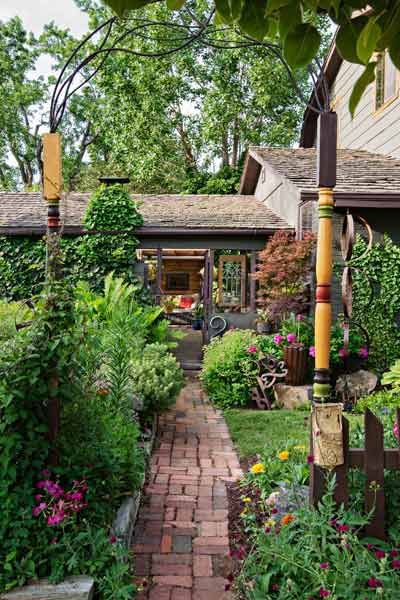
Photo by Dale Horchner
On a corner lot in the city, with an alley running along the back, it can be quite a challenge to create private outdoor space. Holly Fliniau knows, because that’s exactly the situation she faced when she moved into this Denver home, in 1993.
She didn’t really have a plan when she started landscaping the property, but what evolved could be a textbook example of good garden design. She created a series of “rooms” that flow into one another and yet each have a distinct sense of place. Vine-covered fences and arbors shield various seating areas from the streets and the alley but don’t come across as unfriendly walls. And generous plantings on both sides of the sidewalks give neighbors plenty to enjoy as they walk by on their way to the neighborhood park.
[external_link_head]
Shown: Salvaged and new porch posts painted with the same colors support an arch and trellises along the garden’s street side.
Help from a Mother’s Green Thumb

Photo by Dale Horchner
At first, Holly’s main goal was just to create a little privacy and an outdoor dining area. She installed brick paving along one side of the house and at the back, and built a roof over one end so that she could put a table and chairs underneath. Her next project was the picket fence alongside one sidewalk. Then she decided to have her upcoming wedding in her garden. But the leftover lawn and vegetable gardens of the previous owners didn’t quite suffice for a lovely outdoor ceremony. So Holly’s mother, Sandy, came to help put in a large perennial garden with a brick path at the rear of the side yard closest to the street.
Shown: Holly and her mother and gardening partner, Sandy Fliniau, relax on the daybed along with Holly’s Bernese mountain dog, Sophie.
One Perennial Garden Turns into Another
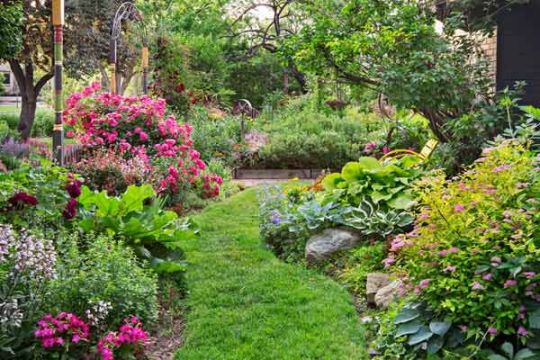
Photo by Dale Horchner
“One project turned into another, and I caught the gardening bug,” says Holly, who delights in the way her outdoor pastime is the polar opposite of her day job as a chemical engineer dealing with hazardous-waste cleanup. “It allows me to exercise the artistic part of my brain.” Before that first perennial garden was done, she was already dreaming about putting in another.
Shown: At the north end of the house, a grassy path meanders between perennial beds.
Secluded Beer Garden
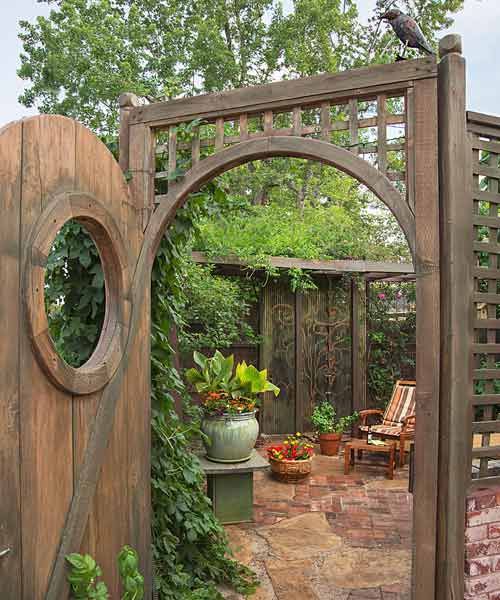
Photo by Dale Horchner
After the wedding, she did just that, toward the front of the house. But there was more. Because her husband (now ex) was interested in home brewing, she created a little beer garden off the back alley, next to the driveway, with a bar and table seating and a vigorous hops vine that softens the walls and surrounding arbors. In the side yard, next to a fence she shares with her neighbor, she squeezed in a secret spot to take an outdoor shower. Directly opposite the breezeway, she added a pergola with a corrugated plastic roof and installed a daybed in the sheltered space underneath. “My dad teases me that I just need an outhouse, and I could live out here,” Holly says, referring to all the amenities she’s put in place.
Shown: A beer garden with a lush hops vine is tucked between the narrow alley and the garage. Holly set the door at an angle to allow easy turning into the driveway. The vine’s flowers exude a heady scent in midsummer. Porthole openings in the arched door were made with timbers salvaged from an old garage.
Dry Gardening Fit for Denver
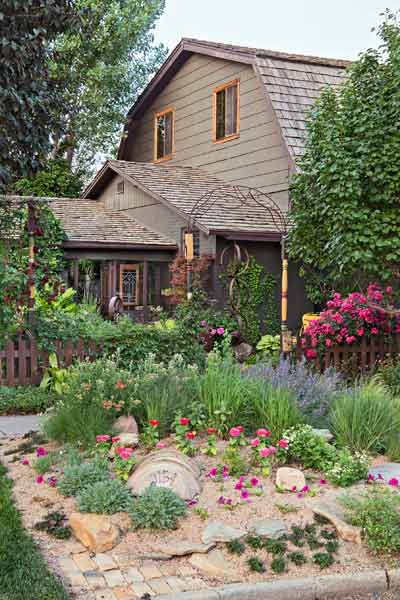
Photo by Dale Horchner
While Holly was making headway installing her outdoor living areas, she was also tackling the planting strips between the sidewalks and the streets. These expanses, which are 10 to 15 feet wide, were just lawn, which she had to constantly irrigate, weed, and mow. “I was paying more each year to my lawn service even as I was reducing the lawn’s square footage,” she says. She discovered a solution when she visited a demonstration xeriscape, or dry garden, now promoted as the most suitable kind of landscaping for arid climates like Denver’s. The garden’s drought-tolerant plantings impressed Holly with their lush look. She decided to copy the idea at her house by putting in one approximately 10-by-15-foot xeriscape garden each year until her streetside gardens were transformed. Frustrated by having to dig up the old lawn, she started just covering it with cardboard and piling on alternating layers of leaves and soil. Adding a blanket of fine pea gravel around the plants keeps weeds down and moisture in.
Shown: In the planting strips between sidewalk and street, Holly has been gradually converting from conventional lawn to water-thrifty perennials. This new bed is also planted with colorful annual petunias and zinnias to fill in until the perennials—including yarrow, catmint, manzanita panchito, and golden storksbill—become well established. Behind the picket fence, new and old ironwork and salvaged ornaments add an artistic personality to the gardens beside the house.
[external_link offset=1]
Lawn to Street Plant Fillers

Photo by Dale Horchner
There is still a bit of lawn visible from the street, but it isn’t the old thirsty kind. To separate the xeriscape beds, Holly planted strips of Bella bluegrass, a dark blue-green grass adapted to Denver’s climate that grows only 4 inches tall, so it almost never needs mowing. “Finally, after getting rid of most of my lawn and replanting what remained with the Bella bluegrass, I could let my lawn service go!” she says happily.
Shown: Orange and scarlet zinnias and purplish sage help fill one of the beds at the far end of the property, which is separated from the street and sidewalk by an arbor covered with clematis and roses. The thickly planted beds don’t require much weeding, as they leave little room for interlopers. Holly loves to sit on the bench at the back to enjoy the view and listen in as passersby comment on her garden.
Playing with Garden Displays
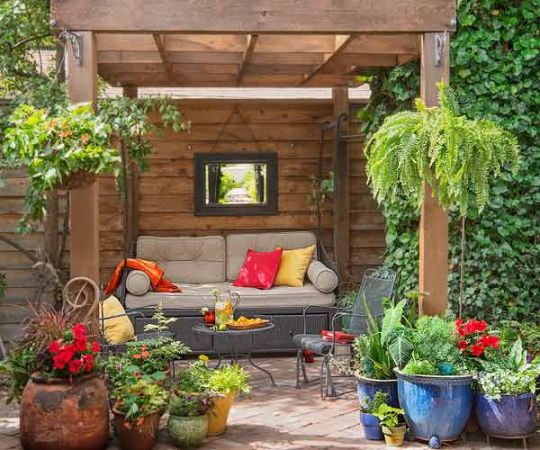
Photo by Dale Horchner
The rest of Holly’s yard isn’t a xeriscape, but she takes pride in how much less water it needs than people assume it does, given how verdant it looks. She switches on her sprinkler system a few times each week for about 20 minutes per irrigation zone. “My mom and I have learned that ‘shoehorning in’ plants close together reduces the need for water and weeding,” she says. Conventional advice cautions gardeners against placing plants too close, on the theory that it will lead to disease. But in Denver’s dry climate, Holly hasn’t had a problem. Close spacing also creates spectacular displays, especially when plants are arranged in drifts. “A friend of mine once said that I subscribe to the ‘big bang theory’ of gardening,” Holly says. “My mom describes it as a village of plants all holding hands in support of one another. I think both are good descriptions.”
Shown: A wood pergola shelters a daybed at one end of the brick patio that homeowner Holly Fliniau built off the breezeway to the garage. The bed backs up to a board fence that she shares with her neighbor. Colorful potted plants mark the outdoor room’s entrance and soften the structure’s beefy support posts.
No Fighting Nature
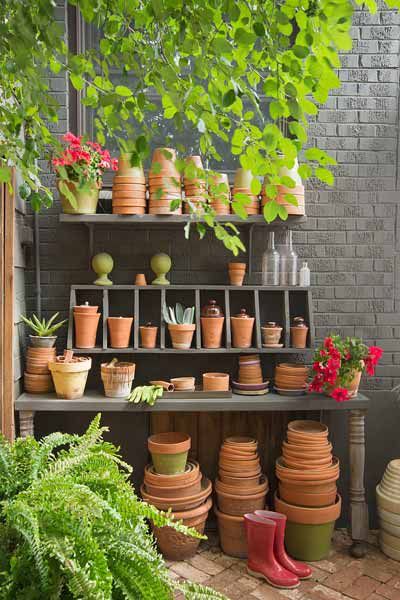
Photo by Dale Horchner
Among the other lessons Holly has learned is not to fight nature. “We are both happier for it,” she says. “If a tree wants to lean a certain way or a plant moves to a new location or won’t leave a location that I don’t want it in, or even if it dies, then that’s fine with me.” She no longer buys grafted roses, having discovered that roses growing on their own root stock recover better after harsh winters. She does, however, try to group some colors together. “That tendency probably comes from me sorting my marble collection by colors as a kid.”
Shown: Holly amassed old clay pots before she realized how fast plants dry out in small containers. So now she displays them mostly as decoration on an old potting bench she cobbled together from odds and ends she found in her garage.
Repurposed Elements
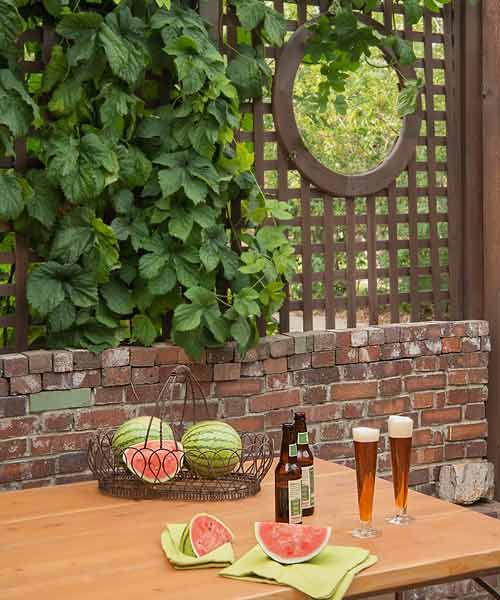
Photo by Dale Horchner
Holly has also learned to repurpose, as garden art, items that might otherwise go into the trash. She used recycled bricks for the back patio and the garden paths and put an old sewing-machine base to work as a plant stand. She salvaged iron rings from decaying whiskey barrels and gave them to her father, who turned them into a rain-chain sculpture that hangs from the back of her house. She also came to love and collect repurposed-iron art from a neighborhood gallery.
Shown: Lattice-topped brick walls offer a glimpse into Holly’s hidden world.
Patina All Around
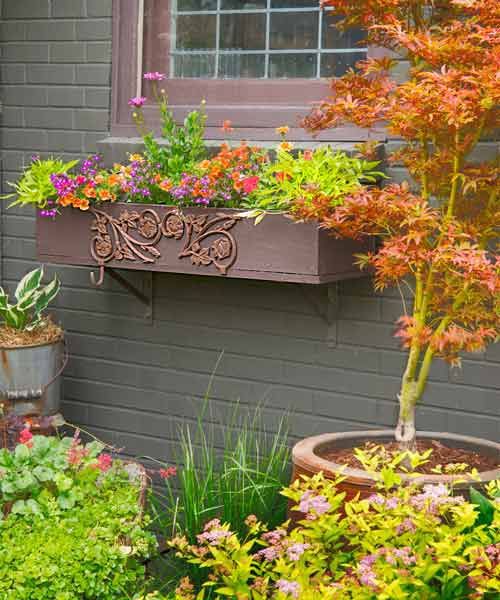
Photo by Dale Horchner
For a gardener who started out on a mission to create private space, one of the biggest surprises was the way gardening opened up a whole new set of friendships. Holly had an artist friend ask if she could set up an easel and paint in the garden. “More came on her heels, and now an entire group of artists paints in my garden every year,” she says. “As a result, I am now an art collector. And through being on garden tours and taking gardening classes, I have made new friends of fellow gardening enthusiasts.”
Shown: A window box planted with orange and purple calibrachoas got a style boost with a metal ornament repurposed from a broken coatrack. Its rusty patina echoes the foliage of a nearby Japanese maple. An old pail is also put to use as a container for a variegated hosta.
DIY Leaf Birdbath
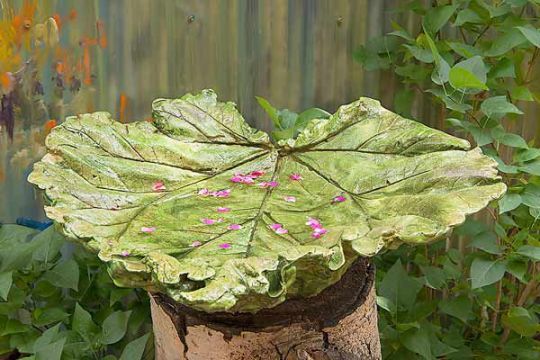
Photo by Dale Horchner
The garden also gives Holly’s mother a way to pass on her vast, mostly self-taught knowledge of gardening to others. Holly says, “Countless times during her visits, I hear her out in the garden answering questions from people passing by the garden on their way to the neighboring park. Some even seek her out now that they recognize her car.”
Shown: A frequent visitor, Sandy made the concrete birdbath using a giant rhubarb leaf as a mold, then painted it; the trunk of a fallen aspen tree serves as its stand.
Colorful Character

Photo by Dale Horchner
Holly says that she herself is shy, so she tends not to join the conversation. But she does love to sit on a wood bench at the very back of the yard, alongside the brick path. The sidewalk is just a few feet away, on the other side of a clematis-and-rose-covered arbor, so she can listen in as people walk by. “They can’t see me sitting there, but I can hear them talk about the garden,” she says. “They’ll say, ‘Oh, look at this,’ and ‘Can you believe that?'” Holly finds it deeply satisfying to hear how they appreciate what she’s accomplished even when they don’t need to be polite. “I’ve also discovered that there is no stopping avid gardeners,” she adds. “They won’t be deterred from coming on in—and that’s all right with me.”
Shown: Most of the dry garden beds feature broken pots buried in the soil that suggest an urn with water spilling out. Instead, drifts of brilliant perennial flowers flow from them. Here, ‘Pink Friesland’ salvia, hot-pink dianthus, and ‘Avalanche’ white sun daisy.
‘Peace’ Rose with a History
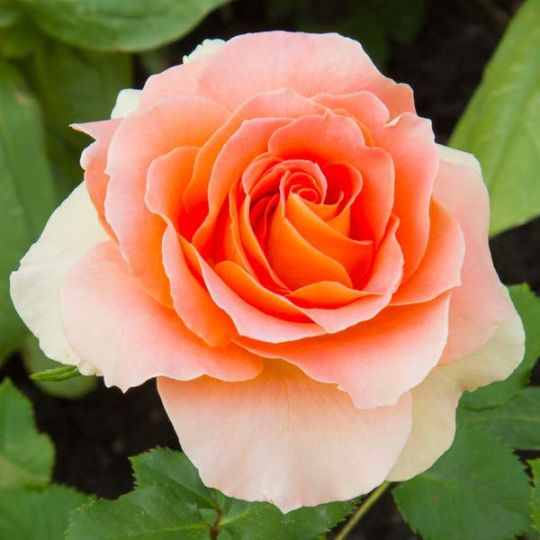
Photo by Dale Horchner
This beauty is a ‘Peace’ rose, one of the most popular roses of all time. French horticulturist Francis Meilland bred it in the late 1930s and sent cuttings to friends in several countries because he feared the German army might invade and destroy it. The rose supposedly arrived in the United States on the last plane available before the German invasion.
‘Polka’ Climbing Rose

Photo by Dale Horchner
For a climbing rose, Holly chose ‘Polka,’ a fragrant variety with peony-like blossoms about 6 inches across. It blooms in waves throughout the summer.
[external_link offset=2]
Color-Enhancing Plant Combos

Photo by Dale Horchner
Holly works to create plant combinations that make individual colors stand out, such as the chartreuse leaves of ‘Frances Williams’ hosta with ‘Purple Sensation’ allium.
Hardy ‘Morden Sunrise’ Rose
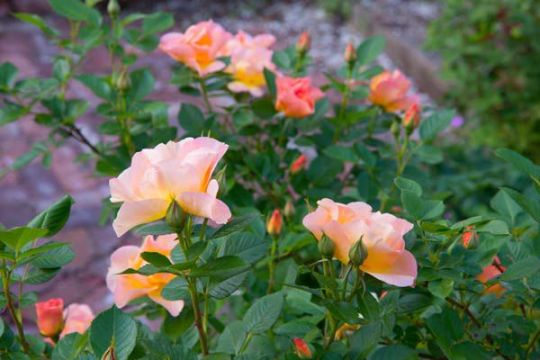
Photo by Dale Horchner
Bred at the Morden Research Station, in Manitoba, Canada, this blush-colored ‘Morden Sunrise’ rose is very cold hardy, surviving down to minus 40 degrees F. The shrubs grow 2 to 3 feet high and spread about 3 feet across.
‘Robinson’s Red’ and Lavender Flowers
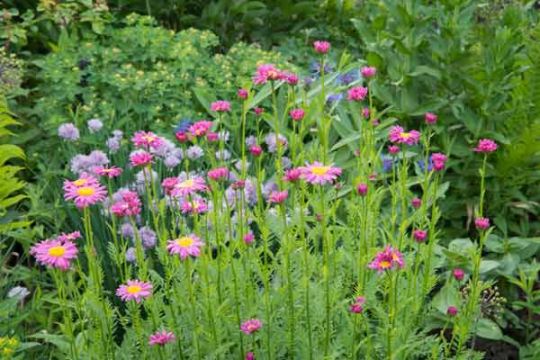
Photo by Dale Horchner
‘Robinson’s Red’ painted daisies grow alongside chive plants that Holly grows primarily for their lavender flowers.
Cohabitating Purples
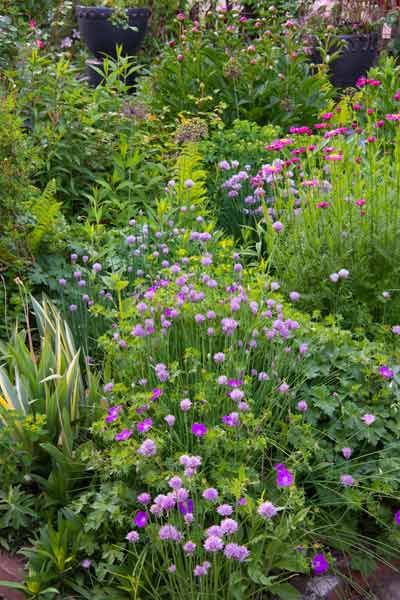
Photo by Dale Horchner
The light-purple flowers of edible chives share a perennial bed with darker-purple cranesbill, also known as hardy geranium. The common name “cranesbill” comes from the shape of the seed capsules.
Show-Stealing Colors

Photo by Dale Horchner
Although backed by airy blue ‘Walker’s Low’ catnip (Nepeta racemes) and spikes of ‘Pink Friesland’ salvia (S. nemorosa), it’s the neon-red pinks (Dianthus) that really steal the show in this bed.
Street-Shielding ‘Alexandra’ Roses

Photo by Dale Horchner
A delicate looking but actually very hardy heirloom variety, the ‘Alexandra’ rose blooms on a trellis separating Holly’s side yard from the street.
Ferns and Hostas Backdrop
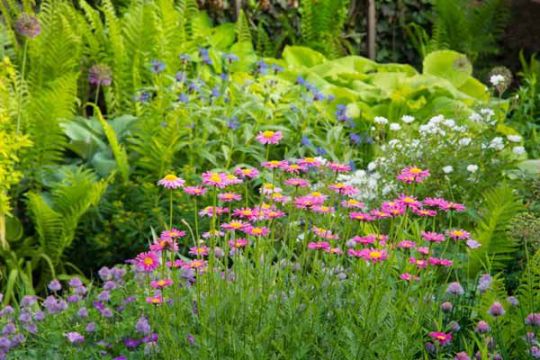
Photo by Dale Horchner
Holly uses ferns and hostas as a backdrop for colorful flowers including light-purple chives, pink ‘Robinson’s Red’ painted daisies (Tanacetum coccineum), white ‘Gourmet Popcorn’ roses, and blue perennial bachelor’s buttons (Centaurea montana).
Accidental ‘Dr. Huey’ Blossoms
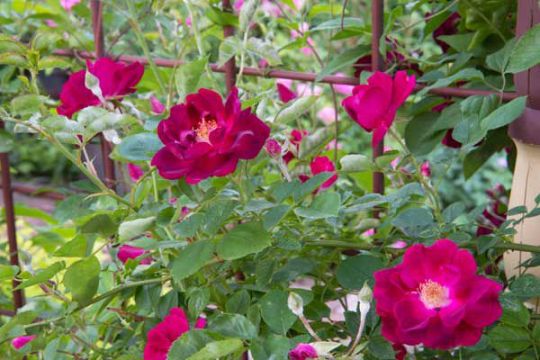
Photo by Dale Horchner
This deep crimson, almost maroon climbing rose is actually an accident. Holly planted a tea rose that was grafted onto the super-hardy roots of the ‘Dr. Huey’ rambling rose. An unusually cold winter killed the graft but not the roots, so the plant sent up new shoots and now she has ‘Dr. Huey’ blossoms instead.
Blue and Pink with Grass All Around
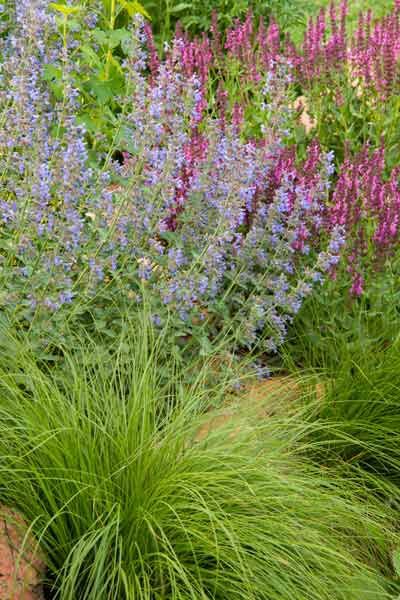
Photo by Dale Horchner
Delicate blue wands of ‘Walker’s Low’ catnip (Nepeta racemes) contrast with bolder spikes of ‘Pink Friesland’ salvia (S. nemorosa). The ornamental grass in the front is Mexican feather grass, also known as ponytail grass (Stipa tenuissima).
Arbor-Hugging ‘Margaret Hunt’ Clematis

Photo by Dale Horchner
‘Margaret Hunt’ clematis is one of several varieties growing on an arbor that screens Holly’s backyard from the sidewalk along one side yard of her house. This clematis blooms on the current season’s growth, so pruning is simpler than with some other clematis varieties. Holly just cuts the vines back in early spring to a foot or two from the ground.
Contrasting Textures and Colors
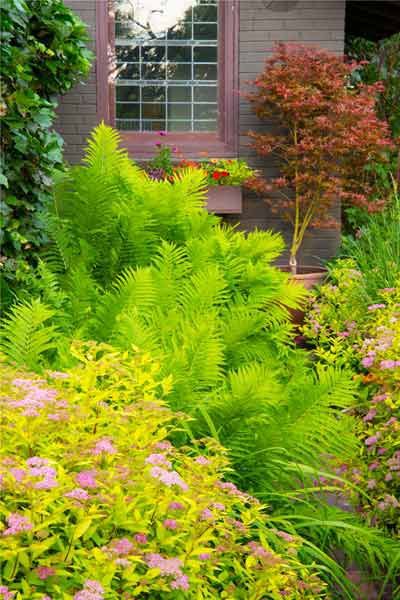
Photo by Dale Horchner
The dusty pink flowers and chartreuse leaves of ‘Limemound’ spirea (S. japonica) contrast in both texture and color with the feathery fronds of ostrich fern (Matteuccia struthiopteris). Next to the house is a rusty-red ‘Shirazz’ Japanese maple in a container.
The Garden Plan
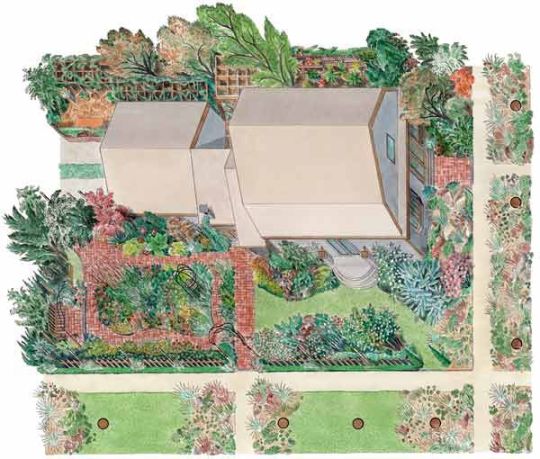
Illustration by Rodica Prato
At Holly Fliniau’s home, curving paths and porch-post arbors shield the house and outdoor seating areas, as do lattice walls, a breezeway, and tall perennials and shrubs. The streetside xeriscape gardens share space with several trees—ornamental plums and a pear, an oak, and maples—that also provide privacy; these are indicated here with red circles but not drawn, to make the gardens more visible. [external_footer]
source https://livingcorner.com.au/creating-a-secret-gardenhow-to-make-a-secret-gardenhttps-cdn-vox-cdn-com-thumbor-fljxxnirmr_4qd9ke92bpj7px_8-0x821400x815-fit-in-1200x630-cdn-vox-cdn-com-uploads-chorus_asset-file-1950713/
0 notes
Text
August 14 2019 Denver
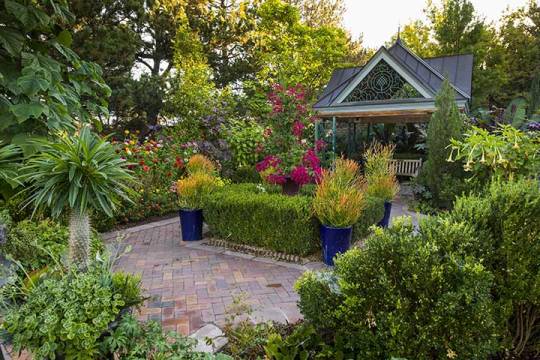
I spent the entire day with Autumn, the first time since she became a teenager that we have been able to have so much time together without other family members joining in. We went first to the Denver Botanic Gardens, one of my favorite places in the city. We walked around the gardens for about an hour and a half, which, in the summer heat, was plenty for Autumn.





According to Wikipedia:
“The Denver Botanic Gardens is a public botanical garden located in the Cheesman Park neighborhood of Denver, Colorado. The 23-acre park contains a conservatory, a variety of theme gardens and a sunken amphitheater, which hosts various concerts in the summer.
Denver Botanic Gardens features North America's largest collection of plants from cold temperate climates around the world, as well as seven diverse gardens that mostly include plants from Colorado and neighboring states.
The world's first Xeriscape Demonstration Garden was created at the Gardens in 1986, and two years later its name was changed to Dryland Mesa. It was based on the "Seven Principles" of Xeriscape, and includes drought-tolerant plants from the arid West and Mediterranean areas.
The Japanese Garden is called Shofu-en—the Garden of Wind and Pines. It was designed by Koichi Kawana in collaboration with Kai Kwahara.

The York Street location of the Botanic Gardens opened Denver's 1st publicly accessible green roof.

The Denver Botanic Gardens also boasts the first conservatory in America that was made entirely of concrete and Plexiglas panes, each of which were designed to channel condensation to the sides of the walls so it would not drip on visitors. The Boettcher Memorial Tropical Conservatory was awarded landmark status in 1973.

We went to Cherry Creek Shopping Center for lunch and to shop for school clothes, which is a very different experience than when I was her age and we actually had a dress code at my high school!
0 notes
Text
the permaculture yard as unintentional political activism: a case study
Before setting out to use land in harmony with natural ecosystems, the permaculturalist, whether operating on ten acres or tenths of an acre, should understand the activism at the root of their choice. As responsible as permaculture might seem to some, the practice can and will…
· be at odds with homeowners associations (HOA’s).
· in certain municipalities, violate the law.
· violate social norms of landscaping, land use, and aesthetics.
Facts are still coming in about the story to follow. Yet it could well be an instructive example of how those engaged in permaculture enterprises and lifestyles need to proceed carefully. Failure to understand the implications of engaging in permaculture could result in damage to one’s reputation, bank account, or in this case, one’s health.
Senator Rand Paul was recently attacked on his property by a neighbor (1). At first blush, the fight apparently started over Paul’s refusal to follow neighborhood rules regarding landscaping. The injuries have kept Senator Paul out of Congress and kicked off a legal battle that will influence both families and their common neighborhood for months.
Mr. Paul, 54, has long stood out in the well-to-do gated neighborhood south of Bowling Green, Ky., that he calls home. The senator grows pumpkins on his property, composts and has shown little interest for neighborhood regulations.
But the spectacle of the incident — one former doctor attacking another in broad daylight — was altogether different. Competing explanations of the origins of the drama cited stray yard clippings, newly planted saplings and unraked leaves.
While the legal proceedings will hopefully get to the bottom of the incidents leading up to the attack, it appears Senator Paul was known for his unwillingness to adhere to neighborhood rules regarding landscaping. A recent Us magazine interview (2) also made mention of his composting and planting a cherry tree in his front yard. Attempting to landscape using low-impact practices like xeriscaping often results in serious and costly clashes with local institutions, such as the House Bill 1070 case in Colorado (2). Permaculture practices like compost heaps run counter to many municipal and HOA rules. To Satoyama Homestead, the compost is black gold. For others, composting involves unsightly heaps of rotting biomass.
The attack on Senator Paul did not appear to have to do directly with his libertarian political leanings, as long as political leanings are interpreted narrowly as disputes over healthcare or taxes.
Matthew J. Baker, a lawyer for Mr. Boucher, called the matter “a very regrettable dispute” between neighbors over a “trivial” matter.
The incident “has absolutely nothing to do with either’s politics or political agendas,” Mr. Baker said in a statement on Monday. “It was a very regrettable dispute between two neighbors over a matter that most people would regard as trivial.”
But if a political act can be defined as an action involving the intersection of power and resource scarcity, landscaping absolutely falls under the umbrella of a political act. As any permaculturalist knows, composting is about conservation of resources and creating a green environment. From a purely financial standpoint, an argument can be made that it’s about saving money on buying compost for a garden.
The attack, if it indeed started over Paul’s permaculture practice, demonstrates the power dynamics involved with the politics of landscaping. Taking Clausewitz’s aphorism that War is the continuation of politics by other means, Paul seems to be the victim of social mores snapping back when pushed too far. The politics of landscaping involve adherence to a strict set of aesthetic rules and, from the permaculturalist’s perspective, clear disregard for natural systems. By taking matters of the environment into his own hands as a homeowner, Senator Paul is a well-known figure falling victim to reactions to his own unintentional activism.
The New York Times article title, “Is Landscaping Drama at the Root of Rand Paul’s Assault?” invokes a kind of tongue-in-cheek attitude toward the situation, the implication being that landscaping drama does not rise to the level of political drama. But budding permaculture fans need to understand the sensitivity of culture to their actions. Plant with caution!
(1) Is Landscaping Drama at the Root of Rand Paul’s Assault? By NICHOLAS FANDOS, NOAH WEILAND and JONATHAN MARTIN. NOV. 6, 2017. New York Times
(2) "Senator Rand Paul Cuts His Own Hair: 25 Things You Don’t Know About Me." By Us Weekly Staff. May 27, 2015, published online at www.usweekly.com.
(3) "Opponents say lawn standards should be set among neighbors," By Kevin Darst, Originally published April 13, 2005 in Coloradan
#permaculture#composting#rand paul#activism#landscaping#politics#political activism#political action
2 notes
·
View notes
Text
Easy Garden Planning: Visit a Demonstration Garden
When approaching a new landscaping or planting project, it helps to gather ideas, whether you do so virtually or hopefully in person. A top benefit of being a member of the Association for Garden Communicators (GWA) is access to botanical, demonstration and private gardens. Sometimes, it’s the signs, like this one at the Atlanta History Center. If you travel, you can gather plenty of ideas from…
View On WordPress
#demonstration gardens#low-water landscaping#pollinators#water-wise gardening#xeriscaping strategies
0 notes
Text
32 Easy Ways To Facilitate Stone In Landscape | stone in landscape
32 Easy Ways To Facilitate Stone In Landscape | stone in landscape – stone in landscape
| Allowed to help my personal blog, within this time We’ll demonstrate in relation to keyword. And today, this is the initial impression:
One Golden Day Of May – stone in landscape | stone in landscape
How about picture above? is which incredible???. if you think therefore, I’l l provide you with several image again down below:
So, if you desire to receive these incredible pics about (32 Easy Ways To Facilitate Stone In Landscape | stone in landscape), click on save button to store these pictures to your personal pc. These are all set for download, if you appreciate and want to obtain it, simply click save symbol in the post, and it will be instantly down loaded in your notebook computer.} Lastly in order to gain unique and recent photo related with (32 Easy Ways To Facilitate Stone In Landscape | stone in landscape), please follow us on google plus or book mark this site, we attempt our best to give you daily up grade with fresh and new pictures. Hope you love staying here. For many upgrades and recent information about (32 Easy Ways To Facilitate Stone In Landscape | stone in landscape) photos, please kindly follow us on twitter, path, Instagram and google plus, or you mark this page on book mark area, We try to provide you with update regularly with fresh and new pics, love your exploring, and find the ideal for you.
Here you are at our website, articleabove (32 Easy Ways To Facilitate Stone In Landscape | stone in landscape) published . At this time we are excited to declare that we have discovered an extremelyinteresting contentto be reviewed, namely (32 Easy Ways To Facilitate Stone In Landscape | stone in landscape) Lots of people searching for specifics of(32 Easy Ways To Facilitate Stone In Landscape | stone in landscape) and certainly one of them is you, is not it?
Stone Patio Pavers & Landscape Stone – Penn Stone – stone in landscape | stone in landscape
Garden Landscaping Ideas Pictures Of Landscape Inspiration … – stone in landscape | stone in landscape
Landscape Stone – Delliquadri Landscaping – stone in landscape | stone in landscape
Click On Image To View Decorative Stone Slideshow Smart … – stone in landscape | stone in landscape
Landscape With Natural Stone – stone in landscape | stone in landscape
Click On Image To View Decorative Stone Slideshow Smart … – stone in landscape | stone in landscape
Landscape Stone for Homes and Businesses | Kafka Granite – stone in landscape | stone in landscape
large rocks for landscaping – Roselawnlutheran – stone in landscape | stone in landscape
Landscape Stone | Rolling Rock Building Stone, Inc. – stone in landscape | stone in landscape
Natural Stone Designs – Aspen – stone in landscape | stone in landscape
Knepp Sand & Stone – stone in landscape | stone in landscape
The Rock Stone & Landscape Supply – stone in landscape | stone in landscape
Mountains, Ridge, Volcano, Rocks – stone in landscape | stone in landscape
Stone, Decorative Stone | Norwin Landscape Supply – stone in landscape | stone in landscape
Mountains, Ridge, Valley, Nature, Height – stone in landscape | stone in landscape
Standing Stones – stone in landscape | stone in landscape
Rock Garden Landscaping Ideas – Iimajackrussell Garages – stone in landscape | stone in landscape
Swimming pool landscaping ideas – stone in landscape | stone in landscape
Desert Rock Garden Ideas Xeriscaping Idea With Cactus … – stone in landscape | stone in landscape
Landscaping Rocks and Stones, How to Use Landscaping Rocks … – stone in landscape | stone in landscape
Do it yourself landscaping ideas DIY – BURNCO – stone in landscape | stone in landscape
Landscaping And Outdoor Building , Natural And Beautiful … – stone in landscape | stone in landscape
Landscape Supply Company Plano TX | Contractors Stone Supply – stone in landscape | stone in landscape
Jackson Landscaping Stones | Stone Center of Indiana – stone in landscape | stone in landscape
Minnesota Landscape Design Company – Niwa Design Studio, Ltd … – stone in landscape | stone in landscape
Landscape rock – Arizona Desert Xeriscape – stone in landscape | stone in landscape
Rock Landscaping Ideas | DIY – stone in landscape | stone in landscape
Stones in the morning – stone in landscape | stone in landscape
Landscape Masonry and Stone Walls – Bedford Landscaping – Landscape … – stone in landscape | stone in landscape
Landscape Masonry and Stone Walls – Bedford Landscaping – Landscape … – stone in landscape | stone in landscape
Landscape Stone for Homes and Businesses | Kafka Granite – stone in landscape | stone in landscape
from WordPress https://landscapeusa.club/32-easy-ways-to-facilitate-stone-in-landscape-stone-in-landscape/
0 notes
Text
Keeping Facility Grounds In Top Shape
By Christine Menapace
From the October 2018 Issue of Facility Executive
Imagine a workplace that attracts top hires, increases employee productivity, reduces healthcare costs, and even saves money. Sound too good to be true? Perhaps not. But it may require looking beyond the building envelope to capitalize on the beneficial effects of the outdoors. “It has even been called the new ‘workplace frontier,’” says Megan Horn, principal with BrightView Design Group & Pre Development.
Benefits Of Outdoor Workspaces
In an initiative launched this past June, outdoor retailer L.L. Bean partnered with coworking provider, Industrious, and workplace strategy expert Leigh Stringer, author of The Healthy Workplace: How to Improve the Well-Being of Your Employee—and Boost Your Company’s Bottom Line, to better understand the benefits and barriers of the outdoor environment as it relates to work. The L.L.Bean 2018 Work and the Outdoors Survey revealed:
This past summer, L.L.Bean debuted its first outdoor co-working space in partnership with Industrious, complete with individual workspaces, collaborative conference areas, cycling desks, and outdoor team building activities, to encourage people to spend more time outdoors. (Photo: Elena Saido)
82% of indoor workers liked or loved the concept of an outdoor workspace.
Workers believe there are tangible benefits to working outside. The top five perceived benefits are: improved mood (74%); lowered stress level (71%); relaxation (69%); promotion of health and wellness (66%); and increased happiness (64%)
Respondents say they are most likely to do creative work (77%), brainstorms (73%), or one-on-one discussions (73%) outside. They are least likely to do computer-based work (41%) or conference calls (32%).
Steve Smith, President and CEO of L.L.Bean, said he hopes the initiative “will inspire employees to be creative in finding new ways to incorporate outdoor time in their day. We also hope that by demonstrating the benefits, employers will be supportive of this idea.”
Take the case of Pasadena, CA based Alexandria Real Estate Equities, Inc., which has won multiple awards for its “cluster model” of sustainable buildings and campuses. It cites its mission as “to create ecosystems that ignite and accelerate the world’s most innovative companies.” This means, among other things, providing amenities such as multi-use open green spaces and organic gardens (with accompanying cafes) for its life science tenant companies. At the Torrey Pines Science Park in San Diego, CA, employees can reportedly enjoy lunchtime bocce games, a barbeque patio, or sit in an Adirondack chair beside a garden. “It’s not just the building—it’s also a lifestyle,” Daniel Ryan, Alexandria’s San Diego regional marketing director and executive vice president told the La Jolla Light. “What’s unique about this is the ability to really accelerate discovery.”
Horn concurs. “Having outdoor amenities within and part of the workplace landscape provides opportunity for employees to be more active, and to engage with nature and their peers. This more casual and natural environment provides varied social opportunities that contribute to team building and finding opportunities for casual conversations and engagement—and potential innovations.”
Commercial Landscape Trends
For facility executives, the message is clear: inviting outdoor spaces can not only enhance corporate perception, but can facilitate meaningful work. And measures need not be extreme. Walking paths, shade canopies, comfortable seating, and attractive landscaping can all go a long way. In fact, the National Association of Landscape Professionals (NALP) reports 7% higher rental rates for commercial offices having high-quality landscapes. According to NALP, some of the current trends in commercial landscapes include:
After an initial conversion project delivered significant water and cost savings, Oracle plans to install smart irrigation products at all its California locations. (Photo: Oracle)
Experiential landscape design. Walking and biking paths, outdoor eating areas, garden views, and even the aforementioned bocce or BBQ areas all allow interaction with nature and peers. “Having beautiful grounds makes a facility more inviting to work for, and some companies have developed walking paths and garden areas for employees to have lunch,” says Brian Schoenthaler, marketing coordinator for Grasshopper. “Grounds are typically not high on the order of facilities. However, besides the buildings, they reflect on the company’s image… Landscaping design of new facilities is becoming a higher priority than previous years.”
Climate-cognizant landscaping. Design elements like hardier hardscape materials, retractable awnings, and outdoor heaters allow for extreme or unpredictable weather patterns. Horn comments, “Our best recommendation is to understand the natural processes that impact sites, to work with nature instead of against it, and leveraging the landscape’s inherent ability to respond and repair.”
Water management and conservation. Native plant use (accustomed to the climate and less water dependent); xeriscaping (designing with low-water use plants); and smarter irrigation technology can aid in more sustainable landscapes—and great cost savings. At Oracle’s Redwood City and Santa Clara, CA facilities, a savings of $573,000 was realized by converting 50 conventional controllers to smart controllers over a three-month period. The project saved 91 million gallons of potable water in one year, reducing consumption by 29%.
“We take the plant type, sprinkler type, slope, and soil type and combine them into a formula to determine the water needs for each zone,” says Brandon DeYoung, vice president general manager at BrightView, which conducted the conversion at Oracle and maintains the grounds. “The controllers also alert us of any issues from the last water cycle.” In addition to using HydroPoint WeatherTRAK controllers, BrightView planted native plants and changed to drip irrigation with high-efficient matched precipitation rate nozzles. With awards from the Silicon Valley Water Conservation Awards Coalition, Oracle has decided to install smart irrigation products at all its California locations.
Enhanced Equipment
The many forms of new technology are indeed making their mark on landscaping equipment, perhaps most notably in the area of ergonomics. According to NALP, the latest tools on the market “consider ease of use and storage while incorporating more eco-friendly innovations. Many lawn mowers, leaf blowers and similar equipment feature low or no emissions, are battery-powered, and are quieter.”
Ergonomics. Landscape equipment manufacturers agree. “Consider the cost of finding, training and replacing [service] employees,” says Schoenthaler. “Grasshopper spends a tremendous about of time in testing and designing products that are durable and ergonomic for the operator.” He continues, “Grasshopper mowers are built with the operator in mind. Seats and footrests are iso-mounted to eliminate vibration to the operator. Hydra-smooth, swing-away steering levers are dampened to provide that comfortable Grasshopper feel and they return to neutral when let go. The result is a smoother ride that leaves the employee less fatigued at the end of the day and helps retain employees.”
Pierre Pereira, director of sales, N.A. for Billy Goat Industries Inc. also sees more ergonomics built into their products. “It used to be a chore product, but the last few years, it’s all about making the job easier.” He mentions how heavy, boxy and noisy backpack blowers with steel housings are now being replaced by lighter, rounder, quieter ones of composite materials.
Productivity. Evolving product design is also making tasks less time consuming. “Mechanical transmissions couldn’t match the actual ground speed to the work,” says Pereira. “Now hydro drive transmissions make that easier.” Mentioning Billy Goat’s new self-propelled PLUGR 25” Hydro-Drive Aerator, he says moving from drum style to reciprocating technology also offers advances in production speed. It’s also easier to maneuver with smoother turning without lifting.
Grasshopper uses the time savings of its zero turn maneuverability and applies it to snow removal, leaf collection, clearing sidewalks, edging, and more. With the company’s FrontMount Power Units, operators remove the front-mounted cutting deck and replace it with commercial-grade implements that cost less than walk-behind or backpack implements. Tasks can also be finished in less time, with less labor.
Connectivity. “Professionals are also integrating more technology—mobile apps, 3D modeling, and drones—into landscape planning,” asserts NALP.
At Billy Goat, a major enhancement has been its “text to video” informational program, available across its entire rental product line. Visual guidance from basic use to changing a belt can be accessed with a text. “It’s a game changer for facilities executives and their personnel,” comments Pereira. He expects telemetrics and “connectivity to your machine” will be an even greater focus moving forward. “Imagine thinking, ‘Did he cut the back quad?’ then checking your computer or mobile device and seeing it was cut at 2pm on Wednesday,” he says.
Pereira recalls a presentation from Adam Lawver, director of campus services at Michigan State University, on developing an evidence-based Landscape Management Plan model that is revolutionizing how the university’s Landscape Services group manages and funds the maintenance of the 2,100-acre developed campus. It involved intelligently mapping the entire campus down to the last sprinkler and equipping personnel with over 1,100 mobile devices, says Pereira. “All the jobs and details are there on your device. From a facility point of view, think of how valuable that is.”
Lawver writes, “A landscape management plan with focused metrics is critical to maintain a safe and aesthetically pleasing physical environment. We decided to go one step further and align the campus master plan and the landscape management plan—the long-term theoretical vision and the day-to-day operational reality—with realistic metrics that allow us to strategically manage with limited resources.” Pereira says the project started with one section to justify the numbers. “It’s amazing. The huge efficiency gains make it pay for itself.”
“Anything that can help you understand, track, manage and analyze your site certainly is valuable,” says Horn. “Long-term data collection will deepen your understanding of the site, and be highly informative for maintenance planning and evaluation. I suspect it would also assist in management and overall facility planning.”
As a final thought, Horn says, “If we look to our university and college campuses you’ll see a very high value placed on the outdoor environment. There’s a direct correlation to successful student recruitment and enrollment. Applying this same sort of attitude—that the exterior environment is the new ‘workforce frontier’ is different than the neat, clean, and somewhat non-descript landscapes of corporate America. While change is slow, we are seeing significant new design and retrofit projects that represent rethinking outdoor environments and making them more social, more dynamic, and more sustainable.”
Menapace served as a former managing editor of Facility Executive for six years. Currently a professional freelance writer and editor, she has over 25 years of experience in publishing, journalism, copywriting, and marketing.
Do you have a comment? Join the conversation in the Comments section below or send an email to the Editor at [email protected].
The post Keeping Facility Grounds In Top Shape appeared first on Turf.
from RSSMix.com Mix ID 8230377 https://ift.tt/2CDBhxt
via IFTTT
0 notes
Text

Untitled.
#photographers on tumblr#cactus spines#Xeriscape Demonstration Garden#Glendale Public Library#Glendale#Arizona
106 notes
·
View notes
Text
Landscaping Plans and Thoughts For Your Home
Landscape configuration is additionally a vital piece of home stylistic theme or home change. A standout amongst the most vital things to be considered amid landscape configuration is to consider what you as of now have. You can't have a decent English garden, if your yard conditions are extraordinary and does not take into consideration this kind of landscaping. You can fuse xeriscaping and dry spell safe components in your landscape in the event that you live in a dry atmosphere. You should consider the accompanying components with regards to choosing a landscape or garden style:
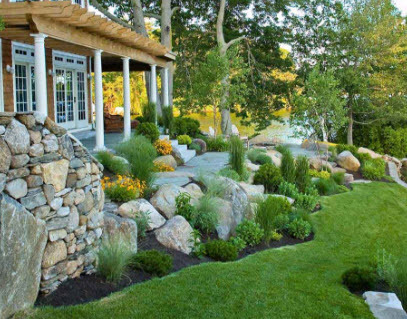
The conditions that is accessible in your yard. Regardless of whether the place is shady or bright generally
The sort of capacities that would happen in your yard
The individuals will's identity suing the yard, for example, pets or youngsters
Regardless of whether you are agreeable to a low-upkeep landscape or whether you can contribute additional time on your yard
The landscape style that would best suit your home
The landscape style that would mirror your way of life the best
There are a few conventional styles in landscaping from which you can pick one to be consolidated in your home. You can likewise choose a couple from arranged styles and can be inventive to make your plan which is one of a kind.
1. In the English style plant landscape; there are numerous perennials and bushes that are utilized in a style that supplements the engineering of your home. You can likewise have other incredible and resplendent components included, for example, water basin or arbor.
2. In the oriental Landscape style, an assortment of plants, evergreens, water and shakes are utilized to make particular look. In this style you can likewise join the Japanese Zen garden of conventional style.
3. The Forest Landscape demonstrates the regular style and has a more wild appearance than a significant number of the other garden styles. On the off chance that you can't spend on support, you can go in for this sort of garden style.
4. The Formal Landscape takes after straight lines, symmetrical examples and exact geometric shapes with very much kept up and pruned plants. The topiary configuration can be for the most part found in these landscapes. This kind of landscaping requires a considerable measure of support.
5. Casual Landscape style makes utilization of plant beds with bended edges. You can discover plants orchestrated in irregular examples. On the off chance that kids may play in the region you can go in for this sort of landscape style.
You can look over one of the previously mentioned styles while going in for home change or landscaping in your home.
#Landscaping#Landscaping Singapore#Singapore Landscaping#Landscaping services#gardening#landscape design
0 notes
Text
Transforming Kuwait's Landscape: Your Guide to Top Landscaping Services?
Kuwait, with its unique blend of desert beauty and urban development, presents a promising canvas for landscaping enthusiasts. Whether you're a homeowner looking to revamp your garden oasis or a business owner aiming to enhance your property's curb appeal, the landscaping services in Kuwait have got you covered. In this article, we'll explore the top landscaping services available in Kuwait and how they can transform your outdoor spaces into captivating havens.
1. Expert Landscaping Services in Kuwait: Kuwait boasts a range of expert landscaping services that cater to diverse needs. From garden design and installation to maintenance, these professionals are skilled in transforming ordinary spaces into extraordinary landscapes. Some of the key services to look out for include:
2. Sustainability and Desert Landscaping: Kuwait's desert environment demands a special approach to landscaping that considers sustainability. Many landscaping services in Kuwait specialize in xeriscaping and desert landscaping techniques. These methods focus on conserving water, using native plants, and creating low-maintenance landscapes that thrive in arid conditions.
3. Landscaping Trends in Kuwait: Stay ahead of the curve by exploring the latest landscaping trends in Kuwait. Some of the trends that have gained popularity in recent years include:
4. Landscaping for Commercial Spaces: Businesses in Kuwait recognize the importance of a welcoming exterior. Landscaping services for commercial spaces offer design solutions that reflect professionalism and create an inviting atmosphere for clients and employees alike.
5. Case Studies: Explore success stories of Kuwaiti properties that have undergone remarkable transformations with landscaping services. These case studies demonstrate how strategic landscaping can enhance property value and aesthetics.
Conclusion: Investing in landscaping services in Kuwait can breathe new life into your outdoor spaces. Whether you seek a serene residential oasis or a commercial property that leaves a lasting impression, the landscaping professionals in Kuwait have the expertise to turn your vision into reality. Stay attuned to the latest trends and sustainable practices to ensure your landscape thrives in Kuwait's unique environment.
1 note
·
View note
Photo

Live Painting on June 16th @ The Xeriscape Garden Party. Parking Lot @ Fort Collins City Hall. 11 am - 2 pm. Lots of vendors, demonstrations, food, live music, and more! (at Fort Collins City Attorney)
0 notes
Photo

Feb 20, Un H2O Garden - Kelowna's demonstration xeriscape garden http://dlvr.it/QH8ncH
0 notes
Text
Landscape Picture Contest Winners Capture Earth's Different Beauty
Mercury in Gemini persons are among the greatest communicators, since Gemini is the sign of Mercury's rulership. As our Office Manager, Amber oversees all facets of human assets, recruiting and administration administration. She beforehand served our firm as an administrative assistant from 2002 to 2011. She holds a certificate in Business Administration from Antioch College-Midwest and an affiliate diploma in Business Data Programs from Sinclair Neighborhood Faculty. To explore the evolution of mind activity previous and ensuing the arising of a thought, the researchers extracted the time course of the fMRI signal beginning 4 seconds earlier than and continuing 12 seconds after the meditator reported a thought. This sign was compared towards the sign surrounding detection of words, to isolate exercise related to introspective versus extrospective ideas.
At any time when doable, look for drought-hardy native or naturalized vegetation to replace thirsty exotics. For instance, contemplate drought-tolerant zoysia or buffalograss as a substitute of thirsty Kentucky bluegrass, or hardy Knockout roses as a substitute of more delicate hybrid tea roses. This molecular tag consists of a methyl group (one carbon and three hydrogen atoms) that cells can attach click here to the cytosine base in DNA, one of many four A-C-T-G bases of which the DNA sequence is comprised. Despite the minuscule dimension of this molecular tag, its presence can instruct the cell to wrap up and compress the surrounding DNA in order that the underlying DNA sequence becomes inaccessible and unreadable to the cell.
Informational images are these like the ones found in most recipe Hubs, mine included, where the image demonstrates how one thing is finished. Another instance might be from my Hub on Theme in Literature the place I used a pic to point out the reader the a basic plot map. The ability to reside with nature, side-by-aspect with critical socio-economic issues, all juxtaposed with the beauty of this extraordinary country may be very highly effective. I've longed to visit this country, so I am grateful for the digital tour you have provided of Lesotho. The music melds with the stunning pictures. It is a very good meld of tone, feeling, tradition, texture, geography, historical past, extraordinary beauty, and sadness.
Rising organismal complexity is nutrient-dependent and pheromone-controlled via conserved molecular mechanisms in species from microbes to man. Jill had kept this ability fine tuned even when she did not have plenty of time. She used it as means to embellish the couples' little residence that was in major need of repairs - both small and large. Regardless that Jeff was self-employed as a useful man, he had little time for his own home. Not as a result of he had an excessive amount of work, he simply wasn't motivated to take action. CNWEST, the government-run information portal of Shaanxi province, mentioned the provincial forestry division sent three teams of personnel to boost public consciousness of hornets.
Resolve on considered one of two completely different design approaches when landscaping with flowers — a one-colour floral garden or a combination of colourful perennials. Yet what most rattan backyard furniture fans is probably not aware of is the best way wherein this material entered the western world, and subsequently turned in style therein. The path linking the primary few wicker-woven pieces to modern-day rattan garden furnishings is a long and sophisticated one, and this text will seek to offer a short perception into its different phases.
We added a wood burning pizza oven and a wooden burning sizzling tub, complete with a shower — excellent for a lot of the yr when it is cold! We layered the deck with steps to have numerous areas to hang around in, culminating down on the patio with a eating area beneath a pergola. Easily add single and multi-story houses to your panorama design. Add doorways, home windows, porch lights, change the siding and roofing materials, select between gable and hip roof kinds - all with just a few mouse clicks. Let the article be more truthful. The virus came from chimpanzees by means of sexual acts, identical to it spreads in people. Don't know why it ignores that reality. Whereas AIDS may be a terrible illness, additionally it is seemingly probably the most preventable of all ailments. Just maintain your self sexually pure, and have no sexual relations till marriage to one individual your entire life. Truly the happiest way to reside. And the most secure.
Xeriscaping is a mode of landscaping that makes use of vegetation, shrubs, ground covers and rocks that want very little water to thrive. The cost of installing a xeriscaped yard is commonly more than merely planting grass and flowers. However, as soon as established the upkeep and water prices are kept low by design. For those who're serious pics about sprucing up your patio or panorama now that warm climate is on the way, you are not alone. In line with a recent survey by Houzz, 18 p.c of U.S. owners plan a patio or landscape addition or substitute in the subsequent two years.
Personalizing a brand new or not too long ago purchased home is the highest motivation for owners to update their landscaping for the primary time, according to Houzz. The majority of homeowners report utilizing their outside spaces for enjoyable including gardening, entertaining and family time. The second purpose for renovation was on account of components of the outside space deteriorating and 42 % report that their last out of doors updates had been greater than 10 years in the past. Landscape gardening is principally the design model attribute of the English gardens dating back to eighteenth century, particularly with the work of Lancelot 'Capability' Brown. It grew to become well-liked in the nineteenth century when the classical type emphasizing meandering curves and clumps had change into old-fashioned. Backyard contractors started utilizing the term 'landscape gardener', within the twentieth century.
0 notes